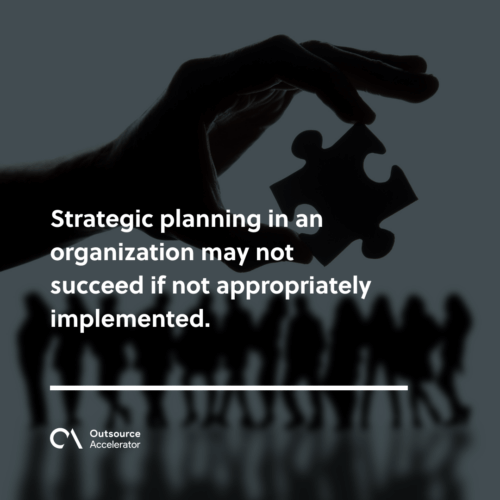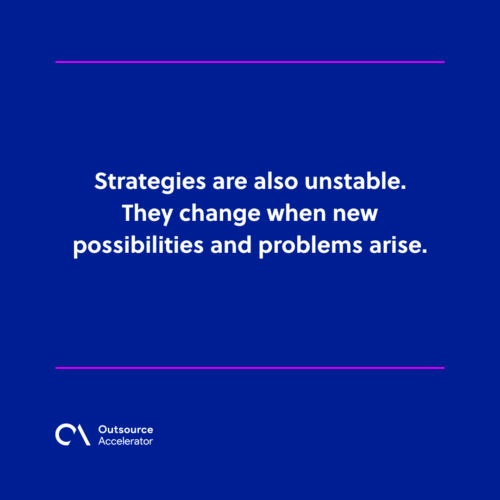How to achieve a successful strategy execution

Strategies that are well-formulated often fail because their success heavily depends on their execution.
Many organizations experience failure in their strategies simply because they cannot overcome the roadblocks that come between their planning and implementation.
A strategic plan is merely the beginning, not the conclusion, of achieving desired goals.
Strategy execution defined
Strategy execution is simply the carrying out of a strategic plan formulated by a business to attain organizational goals. It includes regular structures, operational goals, and processes that position people in charge of particular responsibilities in an organization.
Strategic planning in an organization may not succeed if not appropriately implemented. As a result, it plays a key role in how an organization achieves its strategic goals.

Why is strategy execution important?
Strategic planning and execution go hand in hand. There is no such thing as a perfect strategy—it only happens when it has been transformed and refined through its implementation. Therefore, a strategy can only be perfect if it is properly executed.
Some business leaders would even choose not to disclose their initiatives until after implementation.
Since strategy is determined by execution, they understand that their planning will go through several iterations before it takes on its ultimate, successful form. Hence, they’d rather start with the execution before defining the initiatives.
This keeps them from making excessive promises only to deliver little or even nothing at all.
If a brilliant strategy must meet an excellent implementation for successful strategy execution, then the failure of strategy execution is a major problem for an organization, while execution itself is a vital determinant of success.
Here are the vital keys to achieving successful strategy execution:
Develop an organizational strategy and stick to it
There is nothing to execute if a strategy has not been formulated and agreed upon. From the get-go, you run into a strategy execution gap.
Before the implementation begins, all leaders and their teams must agree to the plan. This is to ensure that everyone is working toward the same objectives. As a result, the organization as a whole develops a shared knowledge of the bigger strategic goal.
Strategies are also unstable. They change when new possibilities and problems arise. Constant communication is important to ensure that the entire organization starts off on the same page and sticks with it.

Align strategy to the team’s jobs
One roadblock to successful strategy execution is when certain roles do not align with a company’s defined strategy. This happens when employment takes place before the strategy is defined or when the current roles align with the previous strategy.
Proper strategy planning ensures that this roadblock is averted.
When this happens, the business may need to have a talent strategy. They determine the new role and put together at least two of the previous job descriptions.
They have to list what personality traits and best qualities other employees in a similar role share.
Third-party experts can also help fill in the gaps when needed. Sometimes, outsourcing talents is the best talent strategy, especially if there is a shortage or if the company needs more people.
Empower employees through effective communication
The importance of effective communication cannot be understated when it comes to carrying out a strategy. Communication should be developed, especially in organizations where most employees have no understanding or even an idea about their strategic objectives.
Everyone in the organization should be aware of both the company’s overarching strategic goals and how their specific roles contribute to attaining them.
Effective strategy execution depends on each employee’s daily tasks and decisions.
Train managers to convey the effects of their teams’ daily work, address the organization in an all-staff meeting, and promote a culture that recognizes accomplishments along the path to achieving significant strategic goals.
Communicating what you desire from your corporate strategy will improve your firm’s performance and empower your people.
Assess progress
The successful strategy execution also depends on ongoing goal-progress evaluation. Key performance indicators (KPIs) and success metrics must be established in the strategic planning phase in order to make this achievable.
A numerical target allows the team to engage in constant performance management and measurement. Based on the results, they can easily determine whether any adjustments are required.
Consider innovation during strategy execution
While innovation is a key factor in a company’s growth, it should not hinder its well-formulated strategies.
Develop a process for evaluating challenges, restrictions, and opportunities as they arise to take advantage of innovation and maintain control over the execution of the current strategic plan.
One can more clearly carry out ideas for effective strategy execution by giving upfront, straightforward answers to their questions.
Bear in mind that a stagnant organization has limited room for growth. Encourage staff members to create fresh ideas, take reasonable risks, and keep an eye on strategic objectives.
When strategy execution unravels, remember this
Strategy execution is not just a notorious but also an ongoing challenge to many organizations. Even the most resilient companies are bound to fail if they do not pay attention to the key elements of implementing their initiatives.
Spending time understanding and utilizing the key points mentioned above will greatly help in the successful execution of your business strategy.

In the end, a successful strategy execution process can be summarized by two things:
- Make sure that the decision-makers are well-established, and
- Have the employees understand their responsibilities and the information they need to fulfill these strategic initiatives







 Independent
Independent




